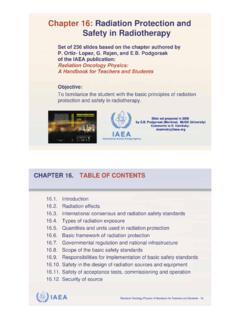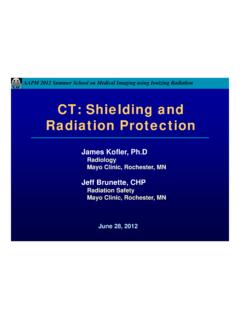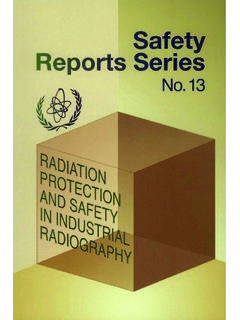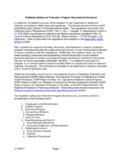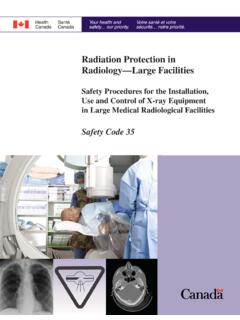Transcription of RADIATION PROTECTION N° 162 - European Commission
1 European Commission . RADIATION PROTECTION N 162. Criteria for Acceptability of Medical Radiological Equipment used in Diagnostic Radiology, Nuclear Medicine and Radiotherapy Directorate-General for Energy Directorate D Nuclear Safety & Fuel Cycle Unit D4 RADIATION PROTECTION 2012. This report was prepared by Quality Assurance Reference Centre for the European Commission under contract N . ENER/10/ and represents those organisations' views on the subject matter. The views and opinions expressed herein do not necessarily state or reflect those of the European Commission and should not be relied upon as a statement of the Commission 's views. The European Commission does not guarantee the accuracy of the data included in this report, nor does it accept responsibility for any use made thereof. Europe Direct is a service to help you find answers to your questions about the European Union Freephone number (*): 00 800 6 7 8 9 10 11.
2 (*) Certain mobile telephone operators do not allow access to 00 800 numbers or these calls may be billed. More information on the European Union is available on the Internet ( ). Luxembourg: Publications Office of the European Union, 2012. ISBN 978-92-79-27747-4. doi: European Union, 2012. Reproduction is authorised provided the source is acknowledged. Printed in Luxembourg 2. FOREWORD. Luxembourg, October 2012. The work of the European Commission in the field of RADIATION PROTECTION is governed by the Euratom Treaty and the secondary legislation adopted under it. Council Directive 97/43/Euratom (the Medical Exposure Directive, MED) is the legal act defining the Euratom requirements on RADIATION PROTECTION of patients and of other individuals submitted to medical exposure. The MED requires the adoption of criteria of acceptability for equipment in order to indicate when remedial action is necessary (including, if appropriate, taking the equipment out of service).
3 In 1997 the Commission issued publication RADIATION PROTECTION 91 (RP91) containing a non-binding set of criteria for acceptability of radiological installations. Later Commission guidance on transposition of the MED into national legislation notes that RP91 "gives only the absolute minimum requirements" and that "holders of installations should make effort(s). to adopt more stringent criteria.. The present report (RP162) updates and considerably expands the scope of RP91. The recommended approach to the establishment and the use of criteria for acceptability of radiological equipment, as well as the technical parameters and values contained in the document, have been extensively reviewed and discussed between 2007 and 2012. This was done in many technical meetings involving specialists in different areas, through an open public consultation from January to June 2010 and in a dedicated workshop held in Dublin in September 2011.
4 The final result is a quite extensive set of non-binding criteria that will help holders of radiological installations assess the (continuing) acceptability of the equipment they use and undertake appropriate remedial action, if indicated. The report should also be useful for regulators when deciding on the adoption of national criteria for acceptability of radiological equipment. However, the Commission does not recommend the direct adoption of the RP162 suspension levels in national regulations, as this may pose unnecessarily stringent limitations on the use of equipment. The adoption of regulatory restrictions on equipment use should be based on careful and thorough evaluation of national circumstances. Hence, RP162 should be used by regulators only as an example of criteria to be considered. While primarily intended for holders of radiological equipment in clinical use and for regulators dealing with safety of such equipment, this report could also be useful for wider audiences.
5 These include designers, manufacturers and suppliers of equipment as well as other players involved in different stages of the equipment lifecycle. The publication of this report in the Commission 's RADIATION PROTECTION series of publications has been recommended by the Group of Experts established under Article 31 of the Euratom Treaty. It is our hope that it will contribute to a continuous improvement of the PROTECTION of the health of the European citizens against the risks accompanying the growing and generally beneficial use of ionising RADIATION in medicine. Augustin Janssens Head of RADIATION PROTECTION Unit Directorate General for Energy 3. CONTENTS. FOREWORD .. 3. CONTENTS .. 5. 1 INTRODUCTION .. 9. Background and purpose .. 9. Basis for criteria for acceptability in the European directives .. 11. Requirements of the Medical Exposure Directive (MED).
6 11. Requirements of the Medical Devices Directives (MDD) and equipment standards .. 13. To whom this document is addressed .. 14. Clarification of terminology and equipment lifecycle .. 14. Criteria for acceptability .. 16. Approaches to criteria .. 16. Identifying and selecting suspension levels .. 17. Special considerations, exceptions and exclusions .. 19. Special considerations .. 19. Old equipment .. 19. Rapidly evolving technologies .. 19. Exclusions .. 20. Establishing conformity with criteria for acceptability .. 21. Wider issues for the hospital, the MPE and the regulator .. 22. Conclusions .. 22. 2 Diagnostic Radiology .. 23. Introduction .. 23. X-ray generators and equipment for general radiography .. 23. Introductory remarks and qualitative criteria .. 23. Suspension levels for X-ray generators and general 25.
7 Radiographic image receptors .. 29. Introductory remarks .. 29. Suspension levels for image receptors .. 30. Mammography .. 33. Introductory remarks and qualitative criteria .. 33. Suspension levels for mammograph .. 34. Dental radiography .. 36. Introductory remarks and qualitative criteria .. 36. 5. Suspension levels for dental equipment .. 37. Fluoroscopic systems .. 40. Introductory remarks and qualitative criteria .. 40. Suspensions levels for fluoroscopy equipment .. 40. Computed tomography .. 42. Introductory remarks and qualitative criteria .. 42. Suspension levels for CT scanners .. 43. Dual energy x-ray absorptiometry .. 44. Introductory remarks and qualitative criteria .. 44. Suspension levels for DXA systems .. 45. 3 Nuclear Medicine .. 47. Introduction .. 47. Activity meters .. 48. Introductory remarks.
8 48. Suspension levels for activity meters .. 48. Well counters and probes .. 49. Introductory remarks .. 49. Suspension levels for well counters and probes .. 49. Gamma camera systems .. 49. Introductory remarks .. 49. Suspension levels for planar gamma camera .. 50. Suspension levels for whole body imaging system .. 51. Suspension levels for SPECT systems .. 51. Gamma cameras used for coincidence imaging .. 51. Positron emission tomography .. 52. Introductory remarks .. 52. Suspension levels for PET systems .. 52. Combined modality systems .. 53. Introductory remarks .. 53. Suspension levels for combined modality systems .. 53. 4 Radiotherapy .. 55. Introduction .. 55. Linear accelerators .. 55. Introductory remarks .. 55. Suspension levels for linear accelerators .. 56. Simulators .. 60. Introductory remarks.
9 60. 6. Suspension levels for radiotherapy simulators .. 60. CT simulators .. 62. Introductory remarks .. 62. Suspension levels for CT simulators .. 63. Cobalt-60 units .. 64. Introductory remarks .. 64. Suspension levels for Cobalt-60 units .. 64. Kilovoltage units .. 66. Introductory remarks .. 66. Suspension levels for kilovoltage units .. 67. Brachytherapy .. 67. Introductory remarks .. 67. Suspension levels for brachytherapy equipment .. 68. Treatment planning systems .. 68. Introductory remarks .. 68. Suspension levels for treatment planning systems .. 69. Dosimetry equipment .. 69. Introductory remarks .. 69. Suspension levels for dosimetry equipment .. 70. 5 References and selected bibliography .. 71. Acknowledgements .. 81. 7. INTRODUCTION. 1 INTRODUCTION. This report provides a compendium of criteria which radiological, nuclear medicine and radiotherapy equipment in normal use ought to be able to pass.
10 The most common form of criterion is a suspension level for a measurement of a performance or safety parameter. Failure to meet a suspension level will establish that the operation of the equipment involved is sufficiently poor to raise an alarm indicating action is required. The assessment up to this point will generally be a matter for the holder1. The equipment failing to meet the suspension level will have to be repaired, temporarily suspended from clinical service, designated usable for limited purposes, or completely suspended from service. This will have serious consequences for the practitioner(s) involved and for hospital/clinic management, particularly if the equipment has to be suspended or replaced. Sets of suspension criteria for particular equipment types are provided with advice on the way they should be used.










